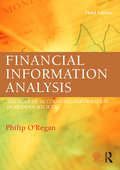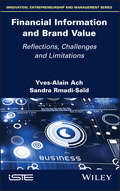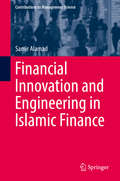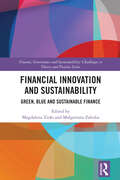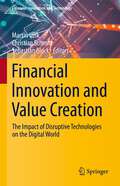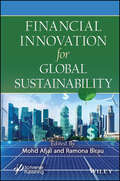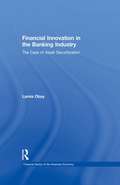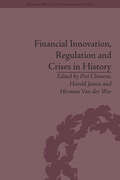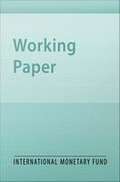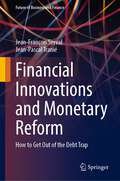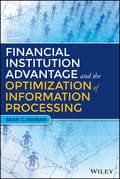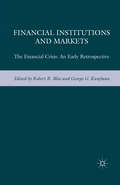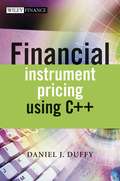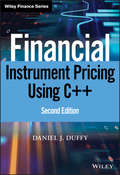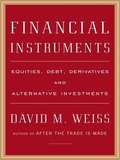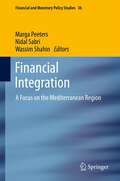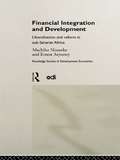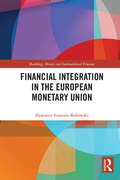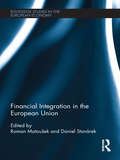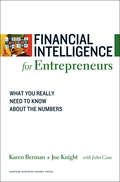- Table View
- List View
Financial Independence for Women: Take Control of Your Money and Live a Balanced Life
by Vered NetaFinancial Independence for Women is about waking up, taking action, and moving forward. In Financial Independence for Women, leading success trainer Vered Neta presents a step-by-step guide to taking control of your money in just six weeks. By discovering the obstacles that keep us from financial success and how to break through them, we can reach financial independence and become role models for ourselves, our daughters, and our world.
Financial Infidelity
by Bonnie Eaker WeilFinancial Infidelity is the #1 problem in relationships - it's a deception so subtle you wouldn't even realize you're cheating. Whether it's a secret credit card, hidden shopping bags, revenge spending, a gambling problem, or more overt financial manipulations and powerplays, the infidelities associated with money can be just as damaging to a relationship as a physical affair. Dr. Bonnie, one of the nation's leading couples therapists, is the first to offer cutting-edge solutions to this pervasive relationship threat, enabling you to:* Identify the risk of Financial Infidelity in your relationship* Understand how buying, rewarding, or controlling behavior with money can open the door to lies, betrayals, and affairs* Understand how childhood relationships to money and love can create damaging emotional links* Separate the value of your relationship from the value of your bank account* Disconnect from harmful emotional and financial behaviors in order to reconnect with your partner and regain trust, intimacy, and romantic sizzleFinancial Infidelity addresses the recent shift in power and money between men and women, and exposes the money, sex, and love triangle, helping you to uncover the hidden financial problems in refinancing your relationship and to heal the inevitable emotional fallout. Dr. Bonnie has a 98 percent rate of success in counseling her patients - this book is an invaluable tool and the next best thing to a session with the doctor herself!
Financial Information Analysis: The role of accounting information in modern society
by Philip O'ReganThe accounting landscape shifted following the era of global financial crisis and accounting information continues to play a vital role. Philip O’Regan’s authoritative textbook provides readers with the tools and techniques to fruitfully analyse accounting and financial data. Updated to reflect changes in corporate governance, regulatory frameworks and new forms of IFRS, the text continues to shed light on the growing emphasis placed on the role of accounting information in formulating financial strategy. Features which add value to this third edition of Financial Information Analysis include case studies in every chapter with numerous supporting articles from the major financial presses, questions for review, and a comprehensive companion website. This essential textbook is core reading for advanced undergraduate and postgraduate students of finance and accounting.
Financial Information and Brand Value: Reflections, Challenges and Limitations
by Yves-Alain Ach Sandra Rmadi-SaïdThe brand is the company's most important asset. In their financial statements, companies are faced with a lack of accounting recognition for the brands they have created, and value recognition for the brands they have acquired. This book studies the nature, characteristics and determinants of brand information published in companies' annual and financial reports. It presents case studies on the methods of evaluating and developing brands, and analyzes annual reports published by listed companies, whose brands appear in international rankings. It reflects on the inadequacy of information and disclosed data to demonstrate the value of brands and the need to ensure that more reliable and relevant financial information is available to investors. Financial Information and Brand Value goes beyond the simple application of conceptual frameworks in order for the reader to master the practices related to brand valuation.
Financial Innovation and Engineering in Islamic Finance
by Samir AlamadThis book provides two important contributions to existing theories in the financial innovation literature. First, it extends the existing literature of innovation orientation to a completely new field and construct that is based on a religious imperative as a framework within which financial innovation is constrained. It explains how an innovation orientation in IFIs can be directed within religious rules, which indicates that innovation orientation in IFIs is a learning philosophy. Second, the book introduces and examines the plasticity of Shariah as a shared boundary object and its dynamic role in managing tension and conflicting values in the financial innovation process. Furthermore, building on the empirical results, the study illustrates the insights that each theoretical lens affords into practices of collaboration and develops a novel analytical framework for understanding religious orientation towards financial innovation. This practical contribution, of the developed framework, could form the basis for a standardised framework for the Islamic finance industry. The book concludes by noting the policy and managerial implications of its findings and provides directions for further research.
Financial Innovation and Sustainability: Green, Blue and Sustainable Finance (Finance, Governance and Sustainability)
by Magdalena Zioło Małgorzata ZaleskaIn recent years, factors such as sustainability, digitalization, climate change, energy transformation, social inclusion, gender parity, and Environmental, Social and Governance (ESG) risk have been playing an increasingly important role in the process of financial transformation. The effect of the impact is increased regulation and guidance for financial markets, in relation to adapting current activities to meet the new challenges, for example: The process of greening finance and spreading the blue wave in finance Building sustainable value in the business models of financial institutions Creating an offer of sustainable financial products Ensuring parity between women and men in the decision-making bodies of financial institutions Sustainable ratings Climate stress tests This book focuses on the intersection between nature and finance and offers a comprehensive overview of the trends, transformations and challenges in finance and the financial markets related to the effects of sustainability concepts or ESG factors. The book has been designed to show these trends, through the evolving subdisciplines of finance, such as green and blue finance. It presents critical recommendations for the ecosystem and network of finance in the era of ESG and sustainability and paints a comprehensive picture of contemporary finance, identifying the factors determining its sustainable transformation.This is one of the first books to present the issues of sustainability and ESG risk in finance through the prism of individual types of finance. Not only will the book appeal to scholars and researchers in the field of banking, economics, finance and accounting, but it will also find an audience among policymakers and practitioners involved in the finance and sustainability discourse.
Financial Innovation and Value Creation: The Impact of Disruptive Technologies on the Digital World (Financial Innovation and Technology)
by Christian Schmitz Martin Užík Sebastian BlockThis contributed volume provides academic insights into the digital financial world. It illustrates the state-of-the-art research on financial technology and innovation with special focus on the impact in society. Technologies are not only door openers for the digital world, but they are also key drivers of change. These key drivers of digitalization, accelerating the pace, are literally forcing individuals to adapt. The authors discuss these dynamics and reflect on society’s adaptability. The first part of the book focuses on cryptocurrencies as disruptive technology. It discusses the status quo, future trends and legal frameworks for virtual money. The second part of the book sheds light on value creation in a digitalized world. The authors discuss digital platforms and economic networks and the impact of digital dominance.
Financial Innovation for Global Sustainability
by Mohd Afjal Ramona BirauFinancial Innovation for Global Sustainability provides essential insight and practical strategies for navigating the evolving landscape of sustainable finance to demonstrate how FinTech can drive environmental sustainability and promote inclusive economic growth. Financial Innovation for Global Sustainability centers on the integration of financial technology (FinTech) with sustainable development and inclusive economic growth. This volume delves into how FinTech can be leveraged to promote environmental sustainability, enhance financial inclusion, and support equitable economic development. The content will explore various aspects of sustainable finance, including green finance, digital financial services, and the role of innovation in driving sustainability within the financial sector. A multi-disciplinary approach draws insights from finance, economics, technology, and environmental studies and features empirical research, case studies, theoretical analyses, and policy discussions. This book will not only discuss current trends and innovations in sustainable FinTech but critically analyze challenges, regulatory hurdles, and ethical considerations. In essence, the book will serve as a comprehensive resource on sustainable financial innovation, offering insights into how FinTech can be a catalyst for positive change in the global financial landscape. Sustainable FinTech sits at the intersection of financial innovation, environmental sustainability, and social equity, reflecting a broader shift in how industries and disciplines are evolving to address the complex challenges of the 21st century. Financial Innovation for Global Sustainability situates itself within this critical discourse, offering a comprehensive exploration of how FinTech can be harnessed to lead the charge towards a sustainable and inclusive future.
Financial Innovation in the Banking Industry: The Case of Asset Securitization (Financial Sector of the American Economy)
by Lamia ObayThis book investigates the motivations behind the adoption of the technique of asset securitization by US commercial banks and its effects on the financial performances.
Financial Innovation, Regulation and Crises in History (Banking, Money and International Finance #2)
by Harold JamesWith contributions from world-renowned figures such as Niall Ferguson and Adair Turner, this volume investigates how financial institutions and markets have undergone or reacted to past pressures, and the regulatory responses that emerged as a result.
Financial Innovation, the Discovery of Risk, and the U.S. Credit Crisis
by Enrique G. Mendoza Emine BozA report from the International Monetary Fund.
Financial Innovations and Monetary Reform: How to Get Out of the Debt Trap (Future of Business and Finance)
by Jean-Pascal Tranié Jean-François ServalWritten by two leading experts on multinational accounting and billion-dollar international investment funds, this book provides a framework for a global reform of the world monetary system, and defines a decidedly new approach to dealing with public debt mortgage, an issue that we can see in many countries in Europe and around the world. The authors put forward a proposal for transforming sterile financial masses, which are withdrawn from the real economy as they no longer bear interest, into wealth. To facilitate this return to the real economy, the authors propose that a significant share of public debt be converted into net equities in the world of business and goods production in order to find new profitable investment projects. The idea is bold, and the authors strive to demonstrate its technical feasibility. They are convinced that this approach can accompany and enhance a movement that has already begun, namely the implementation of vast national and international investment programs in major infrastructures and research projects in innovative sectors. This work builds on the authors’ two previous books, which focus on the monetary system. The first, published in 2010 and including a foreword by former French Finance Minister Christine Lagarde, analyzes the new virtual dimension of money. The second, published in 2014, puts forward an innovative proposal for a new financial regulation aimed at more stable economies. This third book is intended for professionals in the financial industry, including decision makers at banks, accounting and private equity firms, as well as policymakers at central banks and government institutions involved in the implementation of financial and monetary reforms.
Financial Institution Advantage & the Optimization of Information Processing
by Sean C. KeenanThis book will: Discuss unique approaches to meet regulatory requirements and provide resources to these activitiesExplain the link between data governance and model governance and provide an integrated approach to save millions of investment and improve the overall risk/return profile of the firmProvide guiding principles to how to approach and resource model risk and data risk managementAssist System designers within financial institutions to connect and understand the core data architecture level, specific application requirements and performance related to data storage and retrievalExplain why/how huge model and data related gaffs have severely damaged the reputation of several high-profile financial institutions and could have been avoided
Financial Institutions and Markets: The Financial Crisis: An Early Retrospective (Innovations In Financial Markets And Institutions Ser. #6)
by George G. Kaufman Robert R. BlissThis book is a collection of research papers that contribute to the understanding of ongoing developments in financial institutions and markets both in the United States and globally.
Financial Instrument Pricing Using C++
by Daniel J. DuffyOne of the best languages for the development of financial engineering and instrument pricing applications is C++. This book has several features that allow developers to write robust, flexible and extensible software systems. The book is an ANSI/ISO standard, fully object-oriented and interfaces with many third-party applications. It has support for templates and generic programming, massive reusability using templates (?write once?) and support for legacy C applications.In this book, author Daniel J. Duffy brings C++ to the next level by applying it to the design and implementation of classes, libraries and applications for option and derivative pricing models. He employs modern software engineering techniques to produce industrial-strength applications: Using the Standard Template Library (STL) in financeCreating your own template classes and functionsReusable data structures for vectors, matrices and tensorsClasses for numerical analysis (numerical linear algebra ?)Solving the Black Scholes equations, exact and approximate solutionsImplementing the Finite Difference Method in C++Integration with the ?Gang of Four? Design PatternsInterfacing with Excel (output and Add-Ins)Financial engineering and XMLCash flow and yield curvesIncluded with the book is a CD containing the source code in the Datasim Financial Toolkit. You can use this to get up to speed with your C++ applications by reusing existing classes and libraries.'Unique... Let's all give a warm welcome to modern pricing tools.' -- Paul Wilmott, mathematician, author and fund manager
Financial Instrument Pricing Using C++ (Wiley Finance)
by Daniel J. DuffyAn integrated guide to C++ and computational finance This complete guide to C++ and computational finance is a follow-up and major extension to Daniel J. Duffy's 2004 edition of Financial Instrument Pricing Using C++. Both C++ and computational finance have evolved and changed dramatically in the last ten years and this book documents these improvements. Duffy focuses on these developments and the advantages for the quant developer by: Delving into a detailed account of the new C++11 standard and its applicability to computational finance. Using de-facto standard libraries, such as Boost and Eigen to improve developer productivity. Developing multiparadigm software using the object-oriented, generic, and functional programming styles. Designing flexible numerical algorithms: modern numerical methods and multiparadigm design patterns. Providing a detailed explanation of the Finite Difference Methods through six chapters, including new developments such as ADE, Method of Lines (MOL), and Uncertain Volatility Models. Developing applications, from financial model to algorithmic design and code, through a coherent approach. Generating interoperability with Excel add-ins, C#, and C++/CLI. Using random number generation in C++11 and Monte Carlo simulation. Full source code is available by registering at www.datasimfinancial.com. Duffy adopted a spiral model approach while writing each chapter of Financial Instrument Pricing Using C++ 2e: analyse a little, design a little, and code a little. Each cycle ends with a working prototype in C++ and shows how a given algorithm or numerical method works. Additionally, each chapter contains non-trivial exercises and projects that discuss improvements and extensions to the material. This book is for designers and application developers in computational finance, and assumes the reader has some fundamental experience of C++ and derivatives pricing.
Financial Instruments
by David M. WeissA comprehensive, current survey of investment products and instruments Thorough, accessible, and up to date, Financial Instruments is a guide to all of the financial products currently being traded in the world's markets. Through plain language and in a user-friendly format, David M. Weiss, author of After the Trade Is Made, outlines the many tools available and their unique functions, features, and structures. Weiss breaks financial instruments into four broad groups: equities, debt, derivatives, and mutual funds. Under each heading, he explores the many types of related products, including exotic investments such as: ? American Depositary Receipts ? Asset-Backed Securities ? Structured Debt ? Futures ? Swaps ? Unit Investment Trusts Financial Instruments is an indispensable tool for finance professionals-portfolio managers, brokers, financial planners, and institutional investors. It's also a definitive resource for sophisticated individual investors.
Financial Instruments and Cash Waqf: Bridging Islamic Finance with Sustainable Development Goals
by Ahmed Tahiri-JoutiThe book, organized in three parts, offers a guide to constructing financial instruments based on cash waqf in alignment with the Sustainable Development Goals. The first part discusses the alignment between the Shari'ah economic objectives and the SDGs, the Islamic social finance concept, its instruments and institutions and the intersection between Islamic finance and Islamic social finance. The second part presents a product structure that is based on cash waqf and is targeting the SDGs specifically. Some of these product structures involve zakat collection. The third part of the book presents the methodology to gather all these product structures in a national cash waqf ecosystem that is targeting SDGs. The aim of this ecosystem is to increase the impact of the various initiatives and instruments. In addition to this, the third part of the book presents the concept of Waqf offshore centers and the methodology to conceive and implement them. The aim of these Waqf offshore centers is to connect national cash waqf ecosystems and individuals with investment opportunities bringing more impact. This book will be of interest to academics, researchers, and practitioners of not only Islamic finance but sustainable finance.
Financial Instruments to Hedge Commodity Price Risk for Developing Countries
by Yinqiu Lu Salih NeftciA report from the International Monetary Fund.
Financial Integration
by Wassim Shahin Nidal Sabri Marga PeetersThe Arab upheaval and the world's biggest financial crisis after the Great Depression were almost simultaneous in their occurrence. The Mediterranean economies now face a dual challenge of a political and financial restructuring in the light of a shaky economic pedestal on which they stand. In light of this socio-political and economic shift in both inland and in world markets, this book offers a thorough analysis on problems, prospects and the way ahead for the financial integration of the South-Mediterranean region. Several perspectives on financial integration and policy recommendations are put forward from a leading group of researchers specializing on the Mediterranean region.
Financial Integration and Development: Liberalization and Reform in Sub-Saharan Africa (Routledge Studies in Development Economics #No.11)
by Ernest Aryeetey Machiko NissankeFinancial Integration and Development examines the effects of financial liberalization on development, with particular focus on Sub-Saharan Africa. Looking at the relationship between formal and informal institutions, it focuses on structural features that separate formal and informal segments of the financial system. The findings are based on field work conducted in Ghana, Malawi, Nigeria and Tanzania, and lead the way to a reassessment of the design of financial reform programmes and some proposals for effective institution-building policies.
Financial Integration and Risk-Adjusted Growth Opportunities
by Iryna Ivaschenko Gianni De NicolòA report from the International Monetary Fund.
Financial Integration in the European Monetary Union (Banking, Money and International Finance #19)
by Sławomir Ireneusz BukowskiThis book introduces readers to the world of international financial markets and their integration on a global and regional scale. The author presents the theoretical and practical issues concerning the processes of financial market integration, with a particular focus on the monetary union. The empirical research results are based on econometric modeling, thus simplifying them for a non-specialist audience, who can instead concentrate on the author’s conclusions, which comprise the results of these complicated research methods. The author outlines the role and functions of financial markets in the economy, in particular the relationship between financial intermediaries and financial markets and tackles the question of integration of new EU member countries’ financial markets within the eurozone. The integration of financial markets in an international context is inevitable, and the author argues that we must learn how to benefit from it from in terms of economic growth. This book will be a valuable resource for students of economics and finance, particularly those studying financial management and international business and finance, as well as professionals in these fields. Further, this book will be of interest to anyone looking to discover more about the problems of globalization and the integration of financial markets into the modern economy.
Financial Integration in the European Union (Routledge Studies in the European Economy)
by Roman Matoušek Daniel StavárekThis edited collection assesses the level of financial integration in the European Union (EU) and the differences across the countries and segments of the EU financial system. Progress in financial integration is key to the EU’s economic growth and competitiveness and although it has advanced substantially, the process is still far from completion. This book focuses on the pace of financial integration in the EU with special emphasis on the new EU Member States and investigates their progress in comparison with ‘old’ EU countries. The book is the first of its kind to include and evaluate the effects of the global financial crisis on the process of EU financial integration. In particular, the book’s contributors address the issue of whether a high degree of financial integration contributed to the intensification of the financial crisis, or whether a low level of integration prevented countries and financial industries from some of the negative effects of the crisis. Although most of the chapters apply contemporary econometric tools, the technical part is always reduced to indispensable minimum and the emphasis is given to economic interpretation of the results. The book aims to offer an up to date and insightful examination of the process of financial integration in the EU today.
Financial Intelligence for Entrepreneurs
by Karen Berman Joe KnightUsing the groundbreaking formula they introduced in their book Financial Intelligence: A Manager's Guide to Knowing What the Numbers Really Mean, Karen Berman and Joe Knight present the essentials of finance specifically for entrepreneurial managers.Drawing on their work training tens of thousands of people at leading organizations worldwide, the authors provide a deep understanding of the basics of financial management and measurement, along with hands-on activities to practice what you are reading. You'll discover:Why the assumptions behind financial data matter- What income statements, balance sheets, and cash flow statements really reveal- How to use ratios to assess your venture's financial health- How to calculate return on your investments in your enterprise- Ways to use financial information to do your own job better- How to instill financial intelligence throughout your teamAuthoritative and accessible, Financial Intelligence for Entrepreneurs empowers you to "talk numbers" confidently with colleagues, partners, and employees-- and fully understand how to use financial data to make better decisions for your business.


